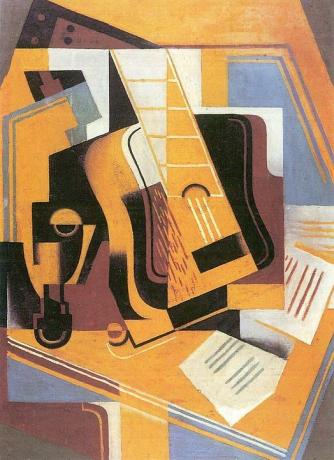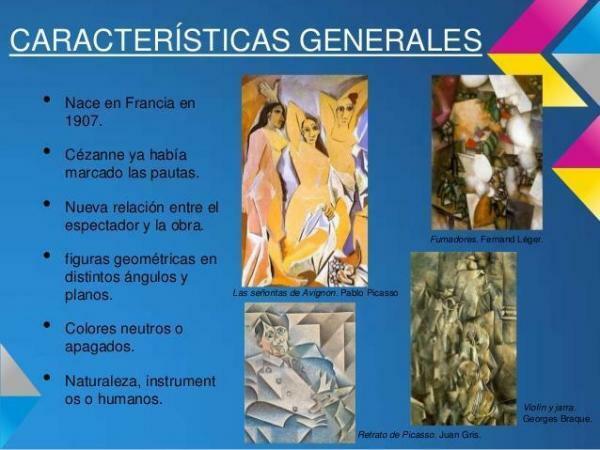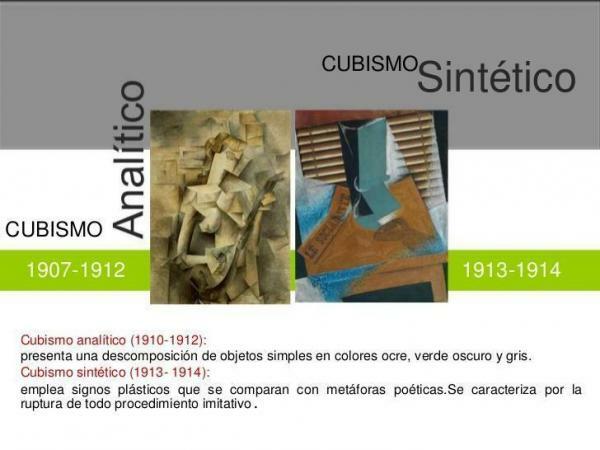Characteristics of cubism in art

Undoubtedly, cubism was one of the most transgressive art movements throughout the twentieth century since it broke with all the guidelines, rules and canons that had been given so far. It was a pictorial style that emerged in France developing between 1907 and 1920, being led by a group of artists among which the Spanish stand out. Pablo Picasso, the creator of this new style. Next, in this lesson from a TEACHER we will try to make a brief summary about the different characteristics of cubism in art.
Index
- How did cubism arise?
- Characteristics of cubism
- Analytical Cubism and Synthetic Cubism
- End of Cubism as an Art Movement
How did cubism arise?
Notably Picasso, before making his first cubist work, one of the most famous in the history of art Les Demoiselles d'Avignon (Las Señoritas de Avignon) in 1907, had nothing to do with Cubism, so that was one of the most questioned issues, that is, what was it that led Picasso to carry out a work of such features.
Well, analyzing a little the historical context of the time, we see how at the beginning of the 20th century a series of exhibitions began to appear in Europe very different from the rest of the European civilizations that were not used to seeing and were related to Iberian art, Celtic art, the african art… The latter is the possible inspiration for Picasso to carry out his worksThey were generally religious figures, totems, masks... in very schematic shapes, with very rigorous and cutting lines. Perhaps he saw in them that the orientation towards that primitivism could be a new way of creating a different and original style.
Cézanne, it is said that he was another of the artists who contributed to the emergence of this new style, since Picasso on some occasion left Of course, he was very interested in his works, works in which, while representing reality, he reduced it to very basic forms and essential.
In this other lesson we will discover the relationship between Pablo Picasso and cubism so that you better understand how this artist forged the new art.

Image: Slideshare
Characteristics of cubism.
We are already beginning to address the issue at hand about the characteristics of cubism in art. The first thing to be clear about this movement is that, as we have said previously, it was a real clash with tradition. past pictorial, since Picasso ignored one of the most persecuted studies by artists throughout history, that of represent perspective, that is, show the three dimensions in a pictorial support such as a canvas, with totally two-dimensional.
Picasso with his new creative style, what he did was capture those three dimensions, but seen from a single plan, giving place to the “multiple perspective”That is, Picasso (and consequently his Cubist followers) what they wanted to do was for a figure to be seen from the front and from the side at the same time, something that is impossible. But what the Cubists do is in the case of a human figure, they unfold their face and, seen from the same plane, they paint the eye from the front and the nose from the profile.
They are also about very geometric figures, rigorous, schematic, conceptual and it did not matter what theme was represented, whether it was landscape, human figures, musical instruments, still lifes... since all were treated equally.
Analytical Cubism and Synthetic Cubism.
To continue with the characteristics of cubism in art we will have to talk about the two different styles that existed at the time. Within the Cubist period, that is, between 1907 and 1920, two very different phases were to take place, the analytical cubism (1907 - 1911) and the Synthetic Cubism (1912-1914).
Analytical cubism
It was characterized by trying to give those three dimensions of which we spoke before, but in its own way, with very sharp geometric shapes and a loss of color very monotonous and opaque that are reduced to gray, black, ocher and brown; This being another of the great differences since some of the movements that preceded Cubism, is That is to say, Fovismo or Impressionism were characterized by the presence of having very striking colors in their paintings.
However, here it was not the color that was of interest, but rather the geometry of the shapes and the different points of view. Some of the most representative works of this stage are the Portrait to Daniel-Henry Kahnweiler, the Picasso dealer and the portrait to Ambroise Vollard.
Synthetic cubism
It developed from the time when the decomposition of cubist figures was such that they almost touched the abstract, indeed, this explains why it was the cubism one of the first movements to need a written part to explain what was being contemplated, as it was difficult to understand in some cases to see what had been represented.
Picasso faced with this situation and that he never considered himself an abstract artist along with other artists such as George Braque, Juan Gris or Fernand Léger, faithful followers of his trend, contributed to creating this new style within cubism in which with the collage technique, that is, with elements that surround us in daily life, whether they are newspaper clippings, sheet music, pieces of cloth, wood ...
They created somewhat more figurative forms, although they were still as small as possible, giving rise to compositions simple and straightforward, however, they were easier to understand since it was more clearly seen what they wanted represent.
Another of the characteristics of cubism in art within this second stage is the return to color, that is, the colors at this time were more vivid. Some of the most representative works of this period were Harlequin, Violin by the wall or The three musicians.

Image: Slideshare
End of cubism as an artistic movement.
Cubism can be terminated around the year 1919, because with the beginning of the First World War in 1914, much of the followers that he had gained over time began to be lost. throughout its period of validity, because many artists were called to war and cubism as such is paralyzed (during this period they referred to cubism as a degenerate art).
Picasso was the first to look for new alternatives during the war period and like him many others who saw their future outlets in other movements such as Dadaism, Expressionism, Surrealism... So only Juan Gris in the postwar period He is the one who remained faithful to his cubist principles and continued to carry out works of this style, although in a more austere and simple way, such as The guitar before the sea.
If you want to read more articles similar to Characteristics of cubism in art, we recommend that you enter our category of Story.


